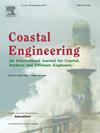Subaerial landslide-induced waves investigated with an adaptively mesh refined multiphase granular flow model
IF 4.2
2区 工程技术
Q1 ENGINEERING, CIVIL
引用次数: 0
Abstract
Impulsive waves generated by subaerial landslides pose a significant threat to coastal or enclosed basin environments. However, simulating the intricate mechanisms involved is challenging due to the multiphase nature of the process, involving air, water, and granular materials interactions. While multiphase computational fluid dynamics (CFD) models offer realistic physics for improved simulations of landslide-induced waves, their high computational cost restricts their use to small-scale laboratory cases or domains. This study presents a multi-variable adaptive mesh refinement (AMR) approach integrated into a multiphase-CFD granular flow model to simulate subaerial landslide-induced wave phenomena. The AMR integration achieves dynamically evolving mesh resolutions in key areas of interest, significantly reducing the total cell count and mitigating computational overhead. The model’s performance is assessed across three laboratory-scale scenarios varying in landslide masses, particle sizes, water depths, and domain sizes. Results demonstrate that AMR maintains static-mesh model accuracy while improving computational efficiency, particularly in high cell count scenarios. Key findings highlight the AMR-enhanced model’s ability to capture both landslide and wave dynamics, showing grid-independence behavior and substantial reduction in computational time. The study emphasizes selecting appropriate AMR parameters, such as the refinement interval, to balance model accuracy and computational efficiency. Additionally, the detailed analysis of landslide dynamics reveals critical influences on wave generation, emphasizing the role of landslide deformation and water penetration in the leading and secondary wave characteristics. Several limitations and computational issues arising from AMR implementation are identified, with recommendations for future improvements. Overall, this study provides valuable insights into the potential of AMR-enhanced multiphase-CFD models for accurately and efficiently simulating landslide-induced waves, offering significant implications for coastal engineering applications.
利用自适应网格细化多相颗粒流模型研究地下滑坡引发的波浪
陆下滑坡产生的冲击波对沿海或封闭盆地环境构成重大威胁。然而,由于该过程具有多相性,涉及空气、水和颗粒材料的相互作用,模拟其中的复杂机制具有挑战性。虽然多相计算流体动力学(CFD)模型为改进滑坡诱发波的模拟提供了逼真的物理原理,但其高昂的计算成本限制了其在小规模实验室案例或领域中的应用。本研究提出了一种将多变量自适应网格细化(AMR)方法集成到多相-CFD 颗粒流模型中的方法,用于模拟陆下滑坡诱发的波浪现象。AMR 集成实现了关键区域网格分辨率的动态演化,大大减少了单元总数,降低了计算开销。该模型的性能在三个实验室规模的场景中进行了评估,这些场景的滑坡质量、颗粒大小、水深和域大小各不相同。结果表明,AMR 保持了静态网格模型的准确性,同时提高了计算效率,尤其是在单元数较多的情况下。主要发现强调了 AMR 增强模型捕捉滑坡和波浪动态的能力,显示出与网格无关的行为,并大大减少了计算时间。研究强调选择适当的 AMR 参数,如细化间隔,以平衡模型精度和计算效率。此外,对滑坡动力学的详细分析揭示了波浪产生的关键影响因素,强调了滑坡变形和水渗透在前波和次波特征中的作用。研究指出了 AMR 实施过程中出现的一些局限性和计算问题,并对未来的改进提出了建议。总之,这项研究为 AMR 增强型多相 CFD 模型准确、高效地模拟滑坡引起的波浪的潜力提供了有价值的见解,对海岸工程应用具有重要意义。
本文章由计算机程序翻译,如有差异,请以英文原文为准。
求助全文
约1分钟内获得全文
求助全文
来源期刊

Coastal Engineering
工程技术-工程:大洋
CiteScore
9.20
自引率
13.60%
发文量
0
审稿时长
3.5 months
期刊介绍:
Coastal Engineering is an international medium for coastal engineers and scientists. Combining practical applications with modern technological and scientific approaches, such as mathematical and numerical modelling, laboratory and field observations and experiments, it publishes fundamental studies as well as case studies on the following aspects of coastal, harbour and offshore engineering: waves, currents and sediment transport; coastal, estuarine and offshore morphology; technical and functional design of coastal and harbour structures; morphological and environmental impact of coastal, harbour and offshore structures.
 求助内容:
求助内容: 应助结果提醒方式:
应助结果提醒方式:


